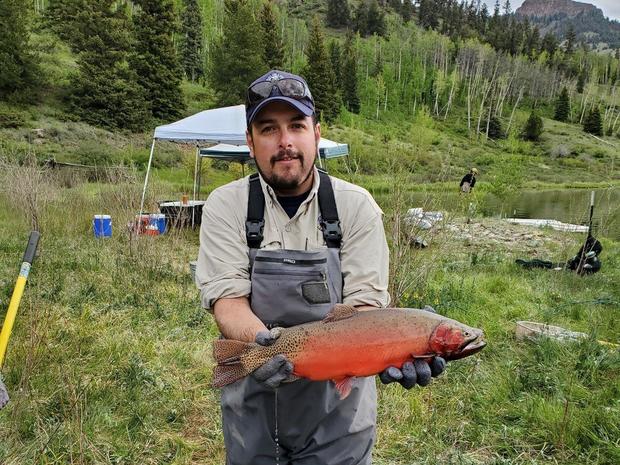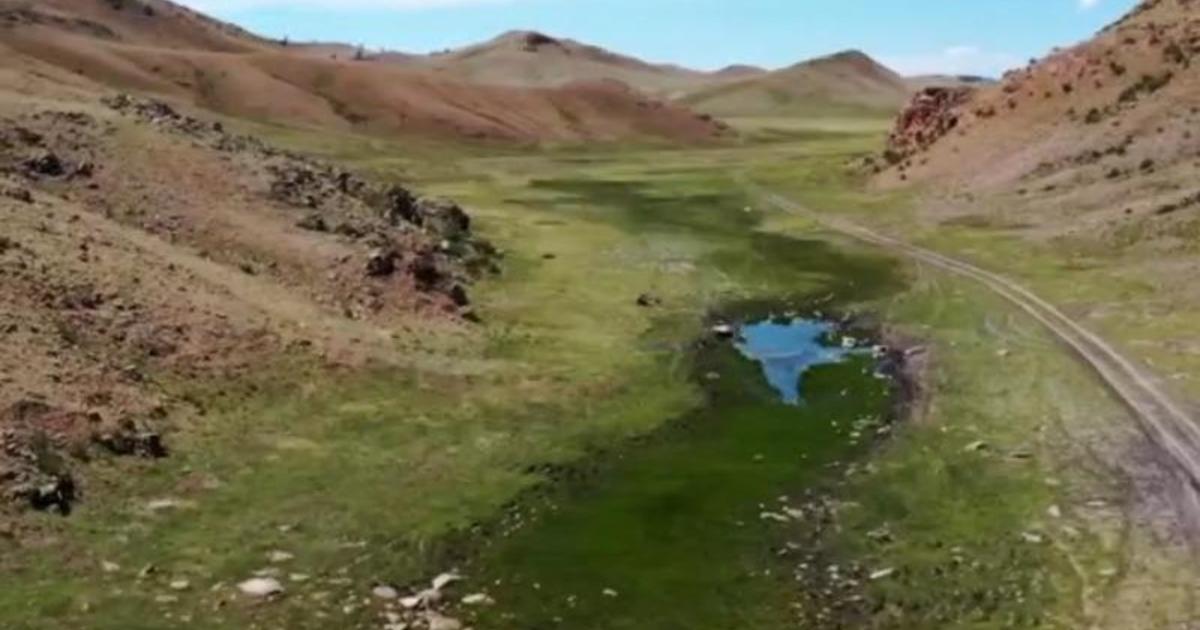Colorado wildlife managers plan to kill off existing fish, restock lake with native trout
Colorado Parks and Wildlife announced Thursday a plan to treat a small lake with an organic poison to wipe out its current population of fish in order to restock the lake next year with a vulnerable species of native trout.
By staff's estimates, the project will create a safe environment for the Rio Grande Cutthroat, a trout subspecies that presently occupies just 12% of the lakes and waterways it previously inhabited.
CPW personnel will begin treatments with the chemical at Rito Hondo Reservoir on July 24. Rito Hondo is located in the Hinsdale County about 30 miles west of Creede.
"These projects are very common across the state," CPW Aquatic Biologist told CBS News Colorado. "This year alone, there are six projects planned statewide. Most of these projects in recent history are success stories for sure. We have (Rio Grande cutthroat) populations in Medano Creek in the Great Sand Dunes National Park because of one of these projects completed in the '80s, Sand Creek from the project in 2020, Lake Fork of the Conejos completed in the '90s, Placer Creek completed in early 2000s, just to name a few off in my area at the top of my head. Those waters are all in the Rio Grande drainage but there are success stories from across the state."
Rotenone will be used. It is an organic piscicide (a poison to gilled animals and invertebrates) that comes from a tropical legume (pea family) root. According to CPW, rotenone has been used by indigenous peoples to capture fish and has been used throughout the world for fish management projects. CPW has used it for more than 80 years.
"Back in the '70s, the product (rotenone) used to be in a different formulation and our understanding of how to use it was not as good," stated Vigil. "Some of those projects didn't work but as fisheries professionals learned more about the use of rotenone, and so we have really been able to complete these projects with much more success."
A report published three years ago by the National Institute of Health indicates rotenone can affect plant life, too. But protocols established three decades ago have helped wildlife managers conduct population controls with it at appropriate levels while limiting impacts to non-target species. The chemical is "de-activated" prior to its release downstream or exposure to desired species.
New Mexico wildlife officials removed nonnative fish from six creeks using piscicide last year to benefit the Rio Grande cutthroat. The National Park Service used a piscicide last year to control invasive species below the Glen Canyon Dam on the Colorado River.
RELATED: Trout thought to be extinct found in Colorado (2018)
The water level at Rito Hondo Reservoir is currently very low. The lake was quickly drained in 2020 when CPW discovered a leak in the lake's dam. The agency took emergency measures following a reported landslide, according to an article from the Alamosa Valley Courier, even though no population centers are located downstream. The lake was created in 1956 to supplement wildlife habitat and holds 500 acre-feet of water at capacity.
CPW will take advantage of the low water level to eliminate the population of non-native brook trout in Rito Hondo. The lake will remain "fishless" through this winter but will be stocked with Rio Grande cutthroats a year from now when dam repair is completed and the lake is refilled with spring runoff.
"The reservoir being drained for repairs gives us the opportunity to reclaim the lake itself and the stream above it without having to treat the whole lake," Vigil said. "The coolest thing about this project is that it's popping up out of nowhere and providing another lake that can grow really good trout."
Brook trout are among the chief competitors with the Rio Grande cutthroat. Eliminating their presence is a necessity, per CPW. By creating a natural hatchery in support of the Rio Grande cutthroat, CPW reverses, at least in part, earlier moves by fish managers that brought about the dilution of the fish's bloodlines and decline of its numbers.
"The introduction of nonnative trout is widely recognized as one of the leading causes of range reduction in cutthroat trout subspecies," a 2008 FWS status report reads. "Since the late 1800s, fishery managers introduced nonnative salmonids (trout and salmon species) into lake and stream habitats of Rio Grande cutthroat trout. Nonnative rainbow, brook, brown trout and Yellowstone cutthroat trout have been introduced extensively throughout the range of Rio Grande cutthroat trout, and they compete (brook and brown trout) and hybridize (rainbow and other cutthroat subspecies) with Rio Grande cutthroat trout."
CPW plans to complement its current efforts by using Rito Hondo as a natural hatchery for the "pure" Rio Grande subspecies.
"For Rito Hondo, the potential of the lake to grow large fish would also produce a lot of eggs and could be a place where we could collect (Rio Grande cutthroat) eggs in the future as backup brood stock for raising in the hatchery," said CPW's Vigil, "and allowing us to have lots of genetically pure fish to stock across the Rio Grande Drainage. The lake being drained gave us this opportunity."
RELATED: Lake City man catches giant 8.9-pound brook trout, breaks Colorado brookie record (2022)
CPW was unable to offer anglers the chance to "fish out" Rito Hondo prior to its draining.
"We were informed that the lake needed to be drained immediately for safety reasons," Vigil said, "and that draining happened so fast that we did not have time to enact an emergency fish salvage. We considered it for the stream, but the whole area is closed because of the construction and we did not want to encourage the public entering the construction zone."
CPW will open Rito Hondo to fishing once the Rio Grande cutthroats have established themselves. Vigil said it could take three to five years for Rito Hondo to produce large, catchable fish that anglers are accustomed to reeling in on the lake.
RELATED: Possible brown trout fishing restrictions going in next year after declining population in Colorado
State and local wildlife managers petitioned the FWS in 1998 to get the Rio Grande cutthroat listed for special protections under the Endangered Species Act. In its 2008 report, the FWS stated, "we find that listing of Rio Grande cutthroat trout as threatened or endangered is warranted."
However, FWS declined to grant the request at that time, instead turning those protections toward other species with higher listing priorities. That "candidate" status for endangered listing remains the same today, despite a 2019 lawsuit that challenged it.
RELATED: Judge vacates part of protection decision on Colorado native trout species (2019)
The Rio Grande cutthroat is one of three native trout indigenous to Colorado, per CPW. The other two are the Colorado River cutthroat (found on Colorado's Western Slope) and the Greenback cutthroat (found on the Front Range). CPW is also working on a variety of projects to restore those populations.





